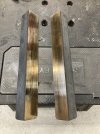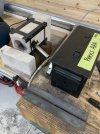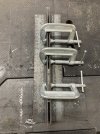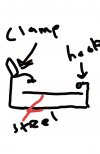- Joined
- May 29, 2004
- Messages
- 399
Great onfo, thanks Stacy, I agree that this should be a sticky.
The BladeForums.com 2024 Traditional Knife is available! Price is $250 ea (shipped within CONUS).
Order here: https://www.bladeforums.com/help/2024-traditional/
Great advise Thank you Sir.There has been a lot of threads and posts about blades warping.
Some comments about warp;
WARP HAPPENS It isn't a plot against you, or bad steel, bad grinding, bad HT, etc......WARP HAPPENS.
Warp is an inherent problem with heating and working steel. You do your best to alleviate the problem, but have to expect it to happen....usually when you don't expect it.
Ways to avoid it;
Think inside the box...OK, inside the blade-
Whatever happens to the grains and crystals, or gnomes and faeries if you prefer, inside the blade will affect warp. Normalizing multiple times, grain refinement, proper forging technique, etc. all will help reduce warp.
Thing outside the box -
Everything around the blade may affect the warp. A cold counter with a warm blade set on it may make the blade warp. Uneven cooling in quench , or uneven heating in temper, etc. Stresses placed on the blade by the way it is held or suspended, etc.
Ways to not have to deal with warp -
There is one sure fire way to not have to deal with a warped blade.....try and straighten it after quench and before temper. This will break the blade in half, and end any need to straighten the warp.
Ways to deal with Warp-
Learning simple straightening practices will help you remove warp. Learning basic HT metallurgy will help you know when you can remove it. There are times when you can easily straighten warp, times when it will laugh at you for trying, and times when it will make you cry.
Start avoiding warp by getting the steel ready for hardening, This involves normalization, stress removal, and grain refinement.
The best time to avoid warp is at austenization temp. Before quenching the blade, pull it out and take a good look. Is it straight or twisted. If so, straighten it now, or that will be the set it takes in quench. Handle the blade gently when transferring from forge/oven to quench tank/plates. It is very rubbery at this point, and can be bent merely by moving it too fast. You have plenty of time to get it smoothly into the tank ( even of 1095).
After the quench, the blade has a period of time before the rubbery austenite starts to convert to brittle martensite. This is both a time when warp can be introduced as well as a time it can be removed. Once the blade has been in the quench long enough to drop below the pearlite nose, around 1000F, pull the blade and give it a good look-over. If there is anything that needs straightening, do it promptly and smoothly. Having all the straightening tools and materials in place is important. You don't have time to go get them. A simple slotted board clamped in a vise can straighten 99% of most warped blades in two seconds. Once the blade cools to where you feel it stiffening STOP STRAIGHTENING.
The next time you can try and adjust the warp is at full tempering temperature after at least one hour soaking time. The 400F or so blade can be gently nudged into shape. If it needs more, put it back in the oven for 15 minutes and repeat. You can do this for hours with no harm. A second temper cycle is needed, and may require additional straightening. Clamping jigs and such during temper can allow this to happen without needing removal or working on 400 degree blades by hand.
If you see a warp later on in post HT grinding and polishing, just reheat the blade to the tempering temperature and soak for an hour..then straighten.
Straightening at room temperature is only for the most minor warped steel, and only for the most steel nerved makers. A blade can break if pushed beyond its elastic limit. Where that limit is can't be known for sure.
Experience is the only teacher for dealing with warp. I normally say that you are best to learn by others experiences, and you can get some great info on warp from others.....but it is your own warp experiences that will teach you how to handle it, avoid it, and straighten it. Don't panic, and don't toss the blade saying, "I ruined three blades today, because they warped." It is a rare blade that can't be straightened.
Don't over think it either. I have heard people say that their new knife is ruined, because the blade tip is warped 1/16" to the left. That isn't ruined, and isn't even what most would call warp.
Lets hear from some others about how you
1) Deal with Warp.
2) Avoid Warp.
Is there a link to what an AL quench plate is ?I did two things on the last blades, following the advices of the experts around here:
1) A little stress relief, the blades, not me.1 hour at 1200F and let cool in the oven
2) After a count of about 7 in the Parks50, clamped the blades in my Al quenching plates.
Can't tell you which one did the trick of both but the blades came out straight as an arrow. This was with Damascus from Alabama Damascus.
Another great explanation after you read it it's like No SH-- That makes sense but as an amateur knife maker, you just don't think of these things. again, thanks for the help.I've had some trouble with warpage when learning to make kitchen knives. Here's what I do right now to avoid or correct warp with forged 52100 carbon steel blades:
After forging, one normalization and two sub critical cycles up to about 1300, down to 900ish and quench. This way, I figure I've austenitized it once after forging, then the sub-critical cycles soften the steel for grinding.
I rough grind but leave about .040" or a little more at the edge. It may be 2" wide and .100 at the spine at this time. When grinding bevels, I hog in pretty good but keep an eye on the blade and try to apply the grinding heat evenly- grinding one whole bevel and then the other will warp it considerably. This seems worse with stainless, AEBL was kind of shocking how it pulled bent in grinding. Now I'll take a couple hard passes on one side, then the other, back and forth. Also, using a push stick can bend the blade in combination with the heat if you don't stay conscious of where it's at.
I flash normalize three times, checking for warp at critical. If I see it, I usually will tap it out on my wood block or the anvil.
Heat back up to critical, using a pipe muffle helps for even heat, and I'm usually having to pump the blade back and forth slightly to get the heel up to heat without overheating the tip. Get even color just a bit above critical.
Quench in P50, no interruption.
Pulling the blade out, I look for warp. Unless it's there pretty bad, I temper for two hours. Then, I take a large wood chipper blade and shim and clamp the blade to it however necessary. Another temper cycle. If it's fixed then, it's done- if not, another temper cycle with shims adjusted, one hour only.
If the warp has been corrected enough that finish grinding the edge from .040 down to .010 or so will fix it, I'm good to go.
If I have warp that's beating all of this, at some point I'll just straighten at critical and re-quench. No more cold straightening in my shop, it's too expensive to make a mistake. Plus, it seems to me as if cold straightening could harm the blade with stress.
Even heating and added thermal cycles, as well as a thick edge during HT have pretty much cleared it up for me. I MUCH prefer prevention to repair.
Added note: I've had a couple blades that frustrated me by just NOT correcting with shimmed tempering that I then tried water cooling while still clamped to the steel plate. In these cases, it seemed to lock in the shimmed shape better when taken out of the clamps. Normally I'd water cool after unclamping. Just something to try, your mileage may vary.
Thick aluminum plates you can clamp down to hold the blade straight. Red Beard Ops on you tube makes a great DIY system using a basic woodworking vise you can pick up at any Harbour Freight or Princess Auto. Just find some thick aluminum and bolt them in. or as in the video grab some angle iron.Is there a link to what an AL quench plate is ?
Thanks Jerry

 nexusgrinders.ca
nexusgrinders.ca



Be careful putting a hardened but un-tempered blade in a straightening jig if there's any warping. You're risking a break. If there is no warp, you don't need to use the jig.After that it’s back in the jig and into the tempering oven.
If you read and look at the pics a little closer you’ll see that it’s not a straightening jig. It’s simply “plates” used to prevent deflection before it sets. I think it’s good practice, and as far as not “needing” them in temper we can disagree on that. As always, YMMV.Be careful putting a hardened but un-tempered blade in a straightening jig if there's any warping. You're risking a break. If there is no warp, you don't need to use the jig.
Almost every maker will do one tempering cycle before attempting to correct any warping.
Here’s my ghetto version of the above:
View attachment 2030408
Angle iron ground flat on one face.
View attachment 2030412
From the quench straight into my wooden bench vise with the flat jig lining it until room temperature. Once cool I clean it up, inspect, and do a hardness check with Tsubosan files. After that it’s back in the jig and into the tempering oven.
View attachment 2030414
I temper it in the jig. Water quench between the two cycles, jig & all. It doesn’t come out until tempering is complete.
Now I’m a very new maker with under 10 blades, but I haven’t had a deflection yet out of quench that didn’t correct itself in this process. I also try to follow all the normalization techniques for forged, but I don’t on stock removal. I do use only high quality, known chemistry steels. I probably just haven’t done enough blades, but the process makes sense to me and appears to be working. YMMV, of course.
Probably you will not read this , but it may help to others knife makers .I assume that you talk about hidden tang knife ? So I ask ,WHY in the name of God anyone should shape tang before HT ??? Leave it as it is , quench , temper blade and then cut and shape that tang !Now reading all of these techniques is great though I'm that guy that likes to know a sure thing before trying it. I have a warp at my tang/spine transition. Sounds like a simple fix except it's a scimitar where the warp is dead center of the rise in the offset handle. I've used 3 pins in my vise to straighten a blade but not where the most shock happens in a knife. Should I try something else due to the curved profile or give it a go?

You will leave it like this ????Without a picture, it is a bit hard to say how to deal with it. First thing I would do is soften the tang by heating it with a torch. Heat the last half until it turns barely red. Watch the colors flow down toward the blade and cool off with a wet rag as the darker color just gets onto the ricasso. Then place in the temper oven and temper at 400-450F ( depending on original hardness) for 30-40 minutes, and straighten while hot. You should be able to remove the warp that way.
That said, warp at or in the tang isn't usually a big issue ... as it gets covered by the handle.

Probably you will not read this , but it may help to others knife makers .I assume that you talk about hidden tang knife ? So I ask ,WHY in the name of God anyone should shape tang before HT ??? Leave it as it is , quench , temper blade and then cut and shape that tang !
Quench this and then cut and shape that tang !

Now about that warp ? What is that ? That is past for me .............
I straighten ball bearing , then I surface ground it to thickness I want ,then I make thermal cycle , then I HT that piece of steel. Just in case, I press it between two thick steel plates until it cools down to room temperature. After HT steel is never 100% straight so I surface ground it again. Then I draw something like knife inside that piece of hard steel and cut/grind it in shape .After that grind that MF bevels drill several holes for scale and that is that !
If time is money, I ask what is the fastest way to make a knife ? My way or to correct warp , bend or cracks and get rid of that decarburization on surface ? Anyway, you have to do everything I did plus the problems that may arise !
Use one day only for HT the steel. Choose the thicknesses and lengths that you use most often. You can finish many pieces in one day. The next day, take a piece of steel that suits you and make that knife concentrating only on that ! Without thinking about whether it will bend, warp or crack or how thick should I leave it before HT .......................
Yeah , but knifes still warpCome-on folks... this is a thread from 2012.
I have no experience with liquid nitrogen , but someone else in Austria HT a dozen M390 and Elmax steel with use of liquid nitrogen and all a straight . Before that I get several S30 V also straight as it can be ? All thick between 4 and 5 mm if that make some difference ?Soak that hardened steel plate in liquid nitrogen and then you will want a carbide hammer too I think
I have no experience with liquid nitrogen , but someone else in Austria HT a dozen M390 and Elmax steel with use of liquid nitrogen and all a straight . Before that I get several S30 V also straight as it can be ? All thick between 4 and 5 mm if that make some difference ?
If you have problem you can clamp them ?
Are you using a stress releaving step with the 14C28N? Some of the 14C28N I have seems like it only wants to warp. I cut out blanks and ended up with bananas with one batch but they actually mostly straightened themselves with the stress relieving step.Yes I am looking for a way to clamp, that fits through the neck of my dewar..
Length of blade, thickness of stock and type if steel all matter. 2 mm 14c28n = frozen banana. 2 mm m390 = 95 % straight and flat. .
Well , your dewar is for storage liquid nitrogen .Make some research on net about Nitrogen bucket or Dewar Flask (Wide Mouth) .................Yes I am looking for a way to clamp, that fits through the neck of my dewar..
Length of blade, thickness of stock and type if steel all matter. 2 mm 14c28n = frozen banana. 2 mm m390 = 95 % straight and flat. .
 knife goes between the steel, should be a really slim piece of equipment if you made it right...
knife goes between the steel, should be a really slim piece of equipment if you made it right...